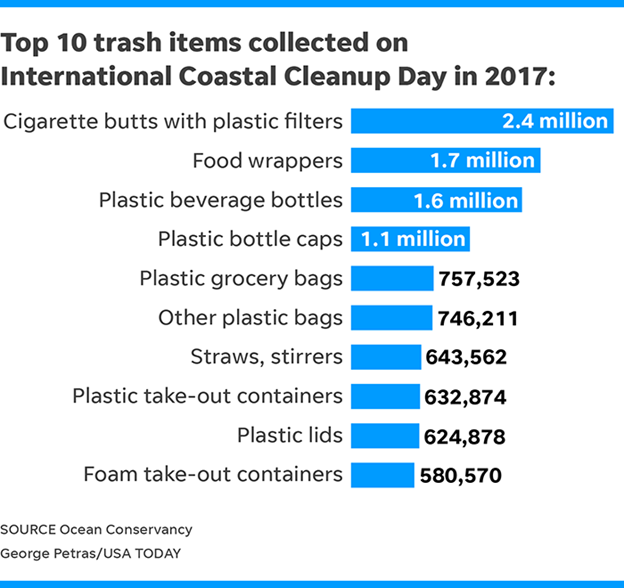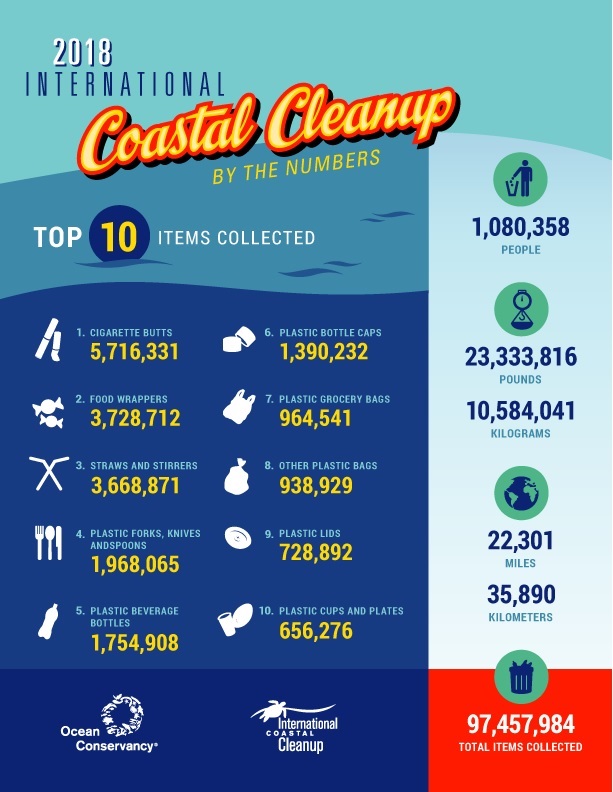Are beach clean-ups effective?
Every year, hundreds of thousands of people across the globe volunteer to be part of a beach clean-up. A beach clean-up is an activity where volunteers gather on beaches along coastlines worldwide and pick up litter and trash on the beach.
The most publicised beach clean-up is International Coastal Cleanup Day, which typically takes place every September. It is run by the non-profit environmental group Ocean Conservancy.
Nicholas Mallos, the director of Ocean Conservancy’s Trash Free Seas programme, notes that there has been a trend over the years where plastic trash items have been steadily creeping into the top-ten list of beach trash items collected during beach clean-ups, displacing the usual suspects like beverage cans, paper bags, and rope.1
2017 was the first year where every item on the top-ten list was made of plastic, as can be seen from the infographic below:

The International Coastal Cleanups for 2018 and 2019 again saw the complete domination of the top-ten list by plastic items.
Given that plastic production has been steadily ramping up over the years, this trend does not look as if it will reverse any time soon.


Are beach clean-ups effective?
Although Ocean Conservancy’s annual beach clean-up is considered the most publicised beach clean-up and the one with the largest number of participants, numbering around a million every year, tens of thousands of people volunteer for coastal clean-ups run by other non-profit organisations all year round.
Suppose coastal clean-ups worldwide are a relatively common event every year, with global participants averaging over a million. In that case, this then raises the question of whether they are effective in tackling the growing problem of plastic pollution.
Why is it that, despite having so many of these clean-ups, organisations around the globe hold them year after year? Is it because their efforts are doing little to combat plastic waste pollution? Do coastal clean-ups make a difference?
A study into plastic waste entering the ocean puts the figure between 5 to 13 million tonnes every year. Most of this plastic waste never even makes it onto the beaches. They end up in the ocean, eventually sinking to the ocean floor.2
In contrast, Ocean Conservancy’s annual beach clean-ups, over 30 years, with a total of 12 million volunteers, have managed to pick up 220 million pounds of plastic trash. That amounts to approximately 100,000 tonnes over a 30-year period, which is but a tiny fraction of the 5 to 13 million tonnes that end up in the ocean every year.
These figures should make it clear that beach clean-ups have a limited effect on the plastic pollution problem. It is a Sisyphean task— no matter how many times volunteers gather on coastal areas around the world armed with garbage bags and large reserves of willpower and determination, ultimately, their effort and hard work will only provide a reprieve from plastic pollution. Without fail, there will be more plastic trash the next time they return to the beach.
That is if they return for the next clean-up, which is not always a given.
Given such futility, does that mean we should do nothing?
Some experts say that doing something is better than doing nothing.
Jan Andries van Franeker, an ecologist at Wageningen University and Research, says that picking up plastic at beach cleanups will prevent plastic pieces “from entangling animals and ending up in the bellies of seabirds”. 3
Laura Leiva, a marine biologist from the Alfred Wegener Institute, states that, besides the benefit of cleaning up the environment, the action of participating in a beach clean-up has the potential to change people’s minds and attitudes toward plastic trash. “It makes people think about plastic trash,” she says. “By changing the way they perceive it, we will make a difference”. 3
Coastal clean-ups also make sense because it is along the coastline where the flow of plastic begins. It is where plastic waste first enters the ocean.
Oceanographer Dr. Erik van Sebille, and his undergraduate physics student, Peter Sherman, from the Grantham Institute for Climate Change and the Environment at Imperial College London, posit that a sensible strategy against plastic pollution would be to arrest the flow of microplastics where the flow is the largest.
Using a model of ocean plastic movements, they analysed the best places to deploy plastic collectors that would remove the largest volume of microplastics and prevent the most harm to wildlife and ecosystems. According to their analysis, the best place to remove microplastics was off the coast because it was from there that microplastics entered the ocean. 4
“It makes sense to remove plastics where they first enter the ocean around dense coast economic and population centres where there is a lot of marine life,” Dr. van Sebille says. “It also means you can remove the plastics before they have had a chance to do any harm”.
As with many experts’ opinions, both Dr. van Sebille and Sherman agree that the best way to reduce ocean plastics would be to stop plastic pollution at its source.
According to the non-profit environmental organisation Plastic Oceans International, global plastic production sits at 300 million tonnes annually. 5
As has already been mentioned above, it is estimated that 5 to 13 million tonnes of that amount get dumped into our ocean every year. Alarmingly, a report published by the American Chemistry Council in 2019 forecasts that global plastic production will more than double in the future, hitting 756 million tonnes in 2050. 6
Dr. van Sebille and Sherman acknowledge that finding a solution to tackle the problem at its source, that of ever-growing plastic production, will not happen overnight. As such, they believe that a temporary solution is needed, and clean-up projects could be such a solution if done well. 4
US-based artist Chris Jordan, the man behind the iconic and disturbing photographs of bottle caps and other plastic trash found in the stomachs of birds that died after eating these plastic fragments, agrees that cleaning up beaches alone is not going to solve the problem of plastic pollution. 3
“It’s a systemic problem with a thousand different causes, and they all need to be addressed as a system,” he says.
When asked whether that means we should just let trash pile up on our beaches, Jordan insists that clean-ups have a role to play.
We just need to be more realistic about what we set out to achieve.
“I think it’s a real mistake to pretend that we’re saving the world with a cleanup,” Jordan says. “But we should clean up beaches just because it’s the right thing to do.”
That is a message that The Association for Community Awareness(ASCOA) supports. ASCOA’s mission is to improve the quality of life for underserved communities by building self-reliance. One of the things that factors into our quality of life is our waterways and coastlines’ cleanliness. By ensuring that its waterways and coastlines are clean, a community keeps its living environment clean. A community that lives in a clean environment is healthier and happier.
ASCOA’s beach clean-up projects
ASCOA has carried out beach clean-up projects twice, both times at Limbe Down Beach. Before they organised them, no other civil society organisations in Cameroon had attempted to clean the Limbe coastline.
The first beach clean-up took place on 15 September 2018, where ASCOA worked with and received partial funding from Ocean Conservancy as part of Ocean Conservancy’s 2018 International Coastal Cleanup Day.
The second clean-up was funded by a Pollination Project grant and broken down into two phases. The first phase took place on 20 July 2019, the second on 14 September 2019. The second phase saw more civil society organisations joining the clean-up and the volunteer count increasing from the first phase’s 75 volunteers to 114, resulting from ASCOA’s request for more help and awareness of the clean-up spreading. More than 70 tonnes of plastic were collected from Limbe’s beaches during the 2019 clean-up.
Due to debris on the beach being a common sight along the Limbe coastline, ASCOA has decided that doing the right thing is the best thing to achieve its mission. Hence, this beach clean-up project will now be one of ASCOA’s permanent projects, hoping that it will contribute to a positive change to both society and the local community.
References
- Carrig D, ‘Top 10 trash items found littering our beaches and waters – and the weirdest’, USA Today, 27 June 2018, https://eu.usatoday.com/story/news/nation-now/2018/06/27/ocean-beach-pollution-plastic-trash/738173002/
- Jambeck JR, et al. (2015) ‘Plastic waste inputs from land into the ocean’, Science, 13 February 2015, Vol. 347, Issue 6223, pp. 768-771
- Deutsche Welle (DW) website, ‘Plastic pollution: Do beach cleanups really make a difference?’, https://www.dw.com/en/plastic-pollution-do-beach-cleanups-really-make-a-difference/a-46196975
- Smithers R, ‘Collecting plastic waste near coasts ‘is most effective clean-up method’’, Guardian, 19 January 2016, https://www.theguardian.com/environment/2016/jan/19/collecting-plastic-waste-near-coasts-is-most-effective-clean-up-method
- Plastic Oceans website, ‘The Facts’, https://plasticoceans.org/the-facts/
- American Chemistry Council (ACC), ‘Population Growth and Materials Demand Study’, August 2019, https://plastics.americanchemistry.com/IHS-Economic-Growth-and-Materials-Demand-Executive-Summary.pdf